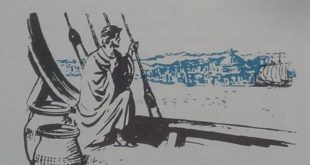Christianity was the movement that spread Across the Roman Empire Pointing the way for the rest of the ancient world toward belief in a single God. The year is 400 A.D. Andropolos paces impatiently up and down the deck of the merchant ship. He is eager to get back home; and to Andropolos, home is the city of Constantinople, a new capital of the Roman Empire. He can already see the walls and buildings of the great city shimmering in the distance. Now the ship is nearing the narrow Bosporus, the waterway where Europe and Asia are hardly a mile apart. The voyage from Ostia, the port of the old city of Rome, had been long and tiresome. Andropolos had been only too glad to leave Italy. The city that was once a hub of the Roman Empire, though still large, had a down at the heel look. Simultaneously the cities of northern Italy were becoming crowded with rough barbarians. Tall Germans also were filling the ranks of Roman legions. In times past, men such as these had been defeated again and again by Roman armies made up of men from Italy, but those victories had been won long ago and Rome had no such fighters left. Yes, Andropolos is thankful to leave Italy. Here in Constantinople the authority of the Roman emperor still counts. Andropolos shakes his head sadly as he recalls what has happened — the Roman Empire is not what it used to be. For Andropolos, though he is Greek born and Greek speaking, proudly calls himself a Roman citizen. The walls of Constantinople on the left grow closer as the ship enters the Bosporus. Soon it will dock in the harbour of the Golden Horn and Andropolos’ long voyage will be over. When he steps ashore, …
Read More »Byzantium and Russia 400 B. C. – 1240 A. D.
THE BEGINNINGS of Russian history date back to the centuries when Byzantium was at the height of its glory. A thousand years before that Herodotus, the Greek explorer, found Greek settlements on the northern shore of the Black Sea. They traded with the Scythians, a tribe of nomads living on the open plains that stretched eastward for thousands of miles to the mountains of Asia. Bordering these plains on the north were the forest lands and above them, in the far north, stretched the frozen wastes of the arctic tundra. In all that vast land there were no barriers, no high mountains to serve as national boundaries. Even the rivers gave little protection against invasion, for they could be crossed when they froze in the winter. As a result, there was a constant shitting of tribes, the strong pushing back the weak. The Scythians who once held the grassy plains above the Black Sea were pushed away by the Sarmatians and they in turn gave way to the Goths in the third century. An invasion of Huns from the Mongolian desert in the fourth century overran everything in its path. It pressed far into Europe, threatening both Constantinople and Rome. All the conquered peoples, including the Slavic tribes of the forest, were forced to pay taxes to Attila, king of the Huns, for many years. Upon his death in the fifth century, the power of the Huns was broken and the tribes won their freedom again. Then followed a series of tribal wars and a general shifting of populations. Where the Slavs came from originally is not known, but they first appear in history on the Vistula River in the fifth century, as subjects of the Huns. It is possible that the name Slavs really meant slaves, since the Huns …
Read More »

